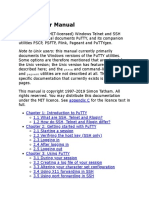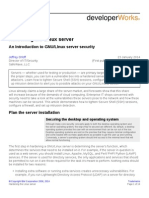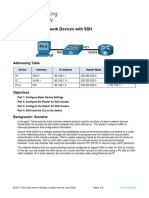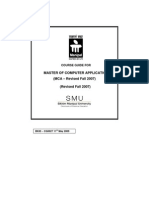Week 2 Part 2
Uploaded by
Pranav Singh RajputWeek 2 Part 2
Uploaded by
Pranav Singh RajputNetworking commands and
SSH
Type 📒 Lecture
Date @March 14, 2022
Lecture # 4
Lecture https://youtu.be/SxDIXtxR33c
URL
Notion https://21f1003586.notion.site/Networking-commands-and-SSH-
URL 9593fb49c2374246b525faff24f19091
Week
8
#
Network & SSH
Accessing remote machines on command line
IPv4 address range
localhost
Networking commands and SSH 1
127.0.0.0/8
Private network
Class A: 10.0.0.0/8
16,777,216
Class B: 172.16.0.0/12
1,048,576
Class C: 192.168.0.0/16
65,536
Public network
Ways to gain remote access
VPN access
SSH tunnelling
Remote desktop: x2go, rdp, pcoip
Desktop over browser: Apache Guacomole
Commercial, over internet: Teamviewer, AnyDesk, Zoho assist, ...
Some important ports
Networking commands and SSH 2
Firewall
Ports open on my machine
Ports needed to be accessed on remote machine
Network routing over the port
Firewall controls at each hop
Protecting a server
SELinux
Networking commands and SSH 3
Security Enhanced Linux mode available on Ubuntu too, apart from server grade
flavours like CentOS, Fedora, RHEL, SuSE Linux, etc.
Additional layer of access control on files to services
Role Based Access Control
Process sandboxing, least privilege access for subjects
Check using ls -lZ and ps -eZ
RBAC items:
user (unconfined_u)
role (object_r)
type (user_home_t)
level (s0)
Modes:
disabled
enforcing
permissive
Tools:
semanage
restorecon
SELinux is recommended for all publicly visible servers
Network tools
Networking commands and SSH 4
High Performance Computing
Look at www.top500.org for statistics
Accessing a remote HPC machine is usually over SSH
Long durations jobs are submitted to a job scheduler for execution
Raw data if large needs to be processed remotely before being transferred to
your machine
Comfort with the command line is a must
Using 3rd party DNS lookup tool
Networking commands and SSH 5
Tool used here: https://tools.keycdn.com/dig
Networking commands and SSH 6
To do a reverse lookup
Networking commands and SSH 7
You might also like
- Hands on Hacking: Become an Expert at Next Gen Penetration Testing and Purple TeamingFrom EverandHands on Hacking: Become an Expert at Next Gen Penetration Testing and Purple Teaming3/5 (3)
- An Overview of SSH: Presentation To Linux Users of VictoriaNo ratings yetAn Overview of SSH: Presentation To Linux Users of Victoria16 pages
- 2 Server Connectivity (SSH) and User Profiles - KaizenNo ratings yet2 Server Connectivity (SSH) and User Profiles - Kaizen9 pages
- Telnet - SSH and The Command Line - DD-WRT Wiki100% (1)Telnet - SSH and The Command Line - DD-WRT Wiki12 pages
- 4 intro Remote Desktop and Remote AssistantNo ratings yet4 intro Remote Desktop and Remote Assistant11 pages
- SSH Command - Usage, Options, ConfigurationNo ratings yetSSH Command - Usage, Options, Configuration5 pages
- Programming and Systems Administration.reportNo ratings yetProgramming and Systems Administration.report4 pages
- 17 Linux Interview Questions and Answers Related ArticlesNo ratings yet17 Linux Interview Questions and Answers Related Articles62 pages
- Lab - Configure Network Devices With SSH: TopologyNo ratings yetLab - Configure Network Devices With SSH: Topology10 pages
- Linux Security and Server Hardening Part-1No ratings yetLinux Security and Server Hardening Part-15 pages
- HowTo - Linux Remove A PDF File Password Using Command Line OptionsNo ratings yetHowTo - Linux Remove A PDF File Password Using Command Line Options26 pages
- Implementing A Secure Home Intranet and VPN Solution Using LinuxNo ratings yetImplementing A Secure Home Intranet and VPN Solution Using Linux31 pages
- Linux Setup SSH - Linux Tutorials - Learn Linux ConfigurationNo ratings yetLinux Setup SSH - Linux Tutorials - Learn Linux Configuration11 pages
- A Hands-On Approach To Linux Privilege Escalation: Tanishq Sharma, Shikhar SaxenaNo ratings yetA Hands-On Approach To Linux Privilege Escalation: Tanishq Sharma, Shikhar Saxena14 pages
- 16.4.7 Lab - Configure Network Devices With SSHNo ratings yet16.4.7 Lab - Configure Network Devices With SSH6 pages
- Linux - Privilege Escalation - Internal All the ThingsNo ratings yetLinux - Privilege Escalation - Internal All the Things2 pages
- 16.4.7 Lab - Configure Network Devices With SSHNo ratings yet16.4.7 Lab - Configure Network Devices With SSH6 pages
- SSH Penetration Testing - Abhinav SharmaNo ratings yetSSH Penetration Testing - Abhinav Sharma25 pages
- 11.2.4.6 Lab - Accessing Network Devices With SSH - ILMNo ratings yet11.2.4.6 Lab - Accessing Network Devices With SSH - ILM11 pages
- Network With Multiple Subnets With Wired and Wireless Lans100% (1)Network With Multiple Subnets With Wired and Wireless Lans10 pages
- 24 Sep 2021 / Document No D21.100.133 Prepared By: Polarbearer Machine Author (S) : Polarbearer & Gibparadox Difficulty: Classification: OfficialNo ratings yet24 Sep 2021 / Document No D21.100.133 Prepared By: Polarbearer Machine Author (S) : Polarbearer & Gibparadox Difficulty: Classification: Official16 pages
- Experiment No. 04: To Analysis The Secure Connection Establishment Through SSH and Telnet OnNo ratings yetExperiment No. 04: To Analysis The Secure Connection Establishment Through SSH and Telnet On7 pages
- Technical Test. System Support Analyst SeniorNo ratings yetTechnical Test. System Support Analyst Senior4 pages
- Install and Configure Freeipa Server On Centos 8 / Rhel 8No ratings yetInstall and Configure Freeipa Server On Centos 8 / Rhel 810 pages
- SSH Mastery: OpenSSH, PuTTY, Tunnels and Keys - 2nd edition: IT Mastery, #12From EverandSSH Mastery: OpenSSH, PuTTY, Tunnels and Keys - 2nd edition: IT Mastery, #12No ratings yet
- 2022 - EN - Quick Start Guide For POE Cameras - V2.0No ratings yet2022 - EN - Quick Start Guide For POE Cameras - V2.024 pages
- Where Can I Find A Bitcoin Machine TROY NY - GoogNo ratings yetWhere Can I Find A Bitcoin Machine TROY NY - Goog1 page
- White Paper - Tessares - Opening The Way For Convergence in The 5G Era With MPTCPNo ratings yetWhite Paper - Tessares - Opening The Way For Convergence in The 5G Era With MPTCP8 pages
- Lit-Blogging Rubric: Fair (0-3) Good (4-6) Very Good (7-8) Excellent (9-10)No ratings yetLit-Blogging Rubric: Fair (0-3) Good (4-6) Very Good (7-8) Excellent (9-10)2 pages
- Advantages and Disadvantages of Using Social Networking Sites of High School Students' Study Habits at LMHMCNo ratings yetAdvantages and Disadvantages of Using Social Networking Sites of High School Students' Study Habits at LMHMC26 pages
- Ap Biology Student Portfolio 2009 - 2010No ratings yetAp Biology Student Portfolio 2009 - 201019 pages
- Network+ Guide To Networks 5 Edition: Transmission Basics and Networking MediaNo ratings yetNetwork+ Guide To Networks 5 Edition: Transmission Basics and Networking Media86 pages
- Shortest Path Forwarding Using OpenFlow PDFNo ratings yetShortest Path Forwarding Using OpenFlow PDF58 pages
- Fkattend User'S Manual: (Version 2.876)No ratings yetFkattend User'S Manual: (Version 2.876)66 pages
- Overview CPU 315-2 DP: Micro Memory Card Required For Operation of CPUNo ratings yetOverview CPU 315-2 DP: Micro Memory Card Required For Operation of CPU9 pages
- Drawing Tool App in VanillaJS With Source Code - SourceCodesterNo ratings yetDrawing Tool App in VanillaJS With Source Code - SourceCodester11 pages
- Hands on Hacking: Become an Expert at Next Gen Penetration Testing and Purple TeamingFrom EverandHands on Hacking: Become an Expert at Next Gen Penetration Testing and Purple Teaming
- An Overview of SSH: Presentation To Linux Users of VictoriaAn Overview of SSH: Presentation To Linux Users of Victoria
- 2 Server Connectivity (SSH) and User Profiles - Kaizen2 Server Connectivity (SSH) and User Profiles - Kaizen
- 17 Linux Interview Questions and Answers Related Articles17 Linux Interview Questions and Answers Related Articles
- Lab - Configure Network Devices With SSH: TopologyLab - Configure Network Devices With SSH: Topology
- HowTo - Linux Remove A PDF File Password Using Command Line OptionsHowTo - Linux Remove A PDF File Password Using Command Line Options
- Implementing A Secure Home Intranet and VPN Solution Using LinuxImplementing A Secure Home Intranet and VPN Solution Using Linux
- Linux Setup SSH - Linux Tutorials - Learn Linux ConfigurationLinux Setup SSH - Linux Tutorials - Learn Linux Configuration
- A Hands-On Approach To Linux Privilege Escalation: Tanishq Sharma, Shikhar SaxenaA Hands-On Approach To Linux Privilege Escalation: Tanishq Sharma, Shikhar Saxena
- Linux - Privilege Escalation - Internal All the ThingsLinux - Privilege Escalation - Internal All the Things
- 11.2.4.6 Lab - Accessing Network Devices With SSH - ILM11.2.4.6 Lab - Accessing Network Devices With SSH - ILM
- Network With Multiple Subnets With Wired and Wireless LansNetwork With Multiple Subnets With Wired and Wireless Lans
- 24 Sep 2021 / Document No D21.100.133 Prepared By: Polarbearer Machine Author (S) : Polarbearer & Gibparadox Difficulty: Classification: Official24 Sep 2021 / Document No D21.100.133 Prepared By: Polarbearer Machine Author (S) : Polarbearer & Gibparadox Difficulty: Classification: Official
- Experiment No. 04: To Analysis The Secure Connection Establishment Through SSH and Telnet OnExperiment No. 04: To Analysis The Secure Connection Establishment Through SSH and Telnet On
- Install and Configure Freeipa Server On Centos 8 / Rhel 8Install and Configure Freeipa Server On Centos 8 / Rhel 8
- SSH Mastery: OpenSSH, PuTTY, Tunnels and Keys - 2nd edition: IT Mastery, #12From EverandSSH Mastery: OpenSSH, PuTTY, Tunnels and Keys - 2nd edition: IT Mastery, #12
- 2022 - EN - Quick Start Guide For POE Cameras - V2.02022 - EN - Quick Start Guide For POE Cameras - V2.0
- White Paper - Tessares - Opening The Way For Convergence in The 5G Era With MPTCPWhite Paper - Tessares - Opening The Way For Convergence in The 5G Era With MPTCP
- Lit-Blogging Rubric: Fair (0-3) Good (4-6) Very Good (7-8) Excellent (9-10)Lit-Blogging Rubric: Fair (0-3) Good (4-6) Very Good (7-8) Excellent (9-10)
- Advantages and Disadvantages of Using Social Networking Sites of High School Students' Study Habits at LMHMCAdvantages and Disadvantages of Using Social Networking Sites of High School Students' Study Habits at LMHMC
- Network+ Guide To Networks 5 Edition: Transmission Basics and Networking MediaNetwork+ Guide To Networks 5 Edition: Transmission Basics and Networking Media
- Overview CPU 315-2 DP: Micro Memory Card Required For Operation of CPUOverview CPU 315-2 DP: Micro Memory Card Required For Operation of CPU
- Drawing Tool App in VanillaJS With Source Code - SourceCodesterDrawing Tool App in VanillaJS With Source Code - SourceCodester
























































































